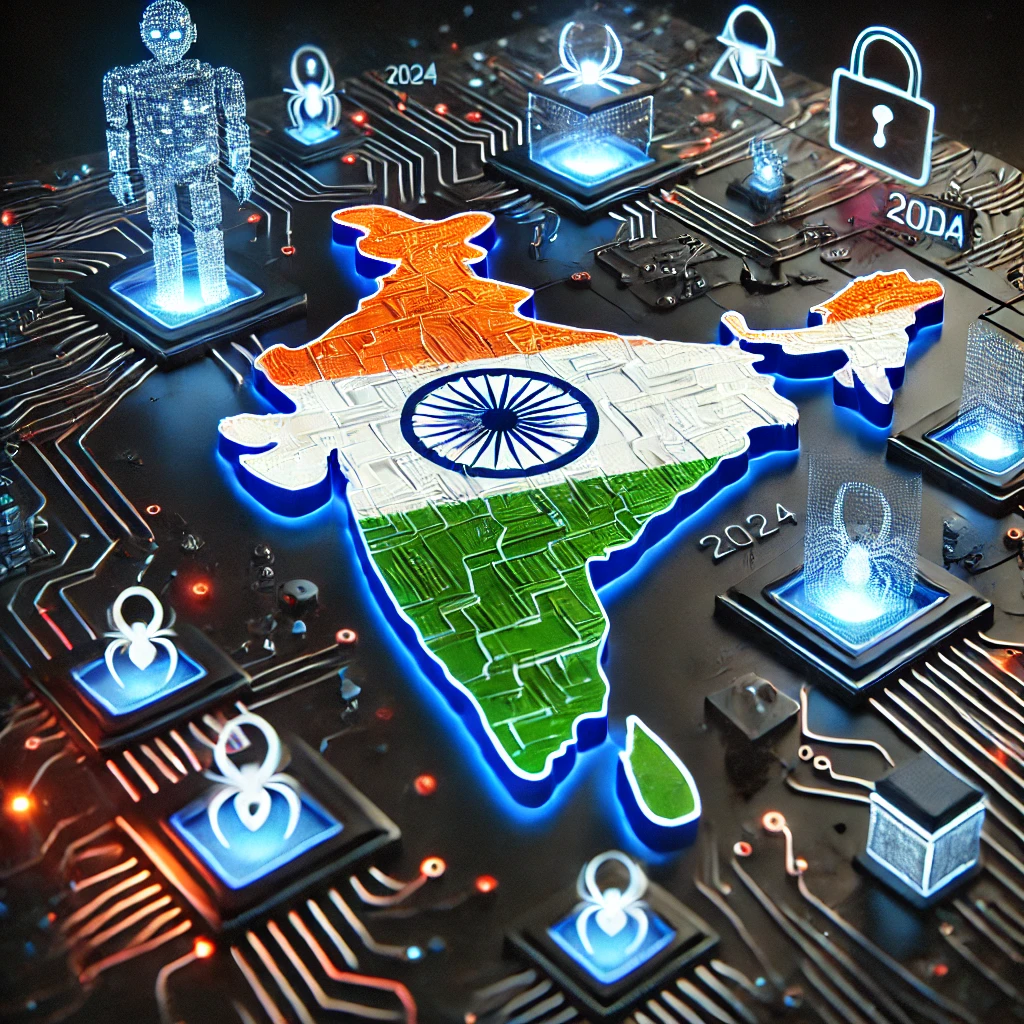The year 2024 has seen a surge in digital threats, particularly from Artificial Intelligence (AI) and related technologies. The increasing sophistication of cyberattacks and AI-enabled disinformation campaigns pose significant security risks and individual privacy risks. A recent glitch in a Microsoft Windows update highlighted the vulnerabilities in our interconnected digital systems. For India, these threats range from deep fakes and ransomware to phishing and cloud security issues. Addressing these challenges requires coordinated efforts between the public and private sectors to enhance cybersecurity measures and foster a culture of digital vigilance.
| GS Paper | General Studies II |
| Topics for UPSC Prelims | Digital threats, Artificial Intelligence, Deep fakes, WannaCry ransomware attack, Phishing, Internet of Things, National Cyber Security Policy, Indian Cyber Crime Coordination Centre, Computer Emergency Response Team – India , Cyber Swachhta Kendra, Digital Personal Data Protection Act 2023. |
| Topics for UPSC Mains | Current Major Cyber Threats that India is Facing, Key Government Initiatives Related to Cybersecurity in India. |
Origin of the Article
This editorial is based on “Disinformation, AI and ‘cyber chakravyuh’” published in The Hindu on 13/08/2024. The article discusses the rising threat of AI and cyberattacks in 2024, emphasizing the need for increased vigilance and coordinated global action to combat these emerging digital dangers, especially in democratic nations.
Relevancy for UPSC Students
Understanding the evolving landscape of digital threats and cybersecurity is crucial for UPSC aspirants. It aligns with GS Paper 2 and GS Paper 3 topics, covering government policies, cyber security, and internal security challenges. This knowledge is essential for tackling questions related to national security and emerging technologies in the examination.

Why in News
The topic of cyber threats and AI is pivotal for the UPSC civil services exam due to its multifaceted implications on national security, governance, and public safety. Previously asked questions have delved into cyber insurance, mandatory reporting of cyber incidents, and elements of cybersecurity, reflecting the ongoing relevance and the need for aspirants to understand emerging digital challenges and government interventions comprehensively.
Current Major Cyber Threats that India is Facing
India is grappling with a range of sophisticated cyber threats that are growing in both frequency and complexity. These threats significantly impact various sectors, from healthcare to finance, making robust cybersecurity measures critical for national security and economic stability.
The Ransomware Rampage
The healthcare sector in India has become a prime target for ransomware attacks. Quick Heal detected over 48,000 instances of the WannaCry ransomware attack. AIIMS Delhi and the Indian Council of Medical Research (ICMR) faced significant breaches, highlighting the sector’s vulnerability.
Phishing Paradox
Phishing attacks have surged, especially in the finance sector. The State Bank of India experienced widespread phishing campaigns where fraudsters used fake SMS messages to steal banking credentials. This underscores the need for robust user education and advanced security solutions.
The Cloud Conundrum
With the rapid adoption of cloud technologies, India faces growing concerns about cloud security. The Air India data breach, which exposed the personal data of 4.5 million passengers, exemplifies the risks associated with inadequate cloud service security measures.
The IoT Invasion
The proliferation of Internet of Things (IoT) devices in India has introduced new security challenges. Vulnerabilities in smart meters, which could allow hackers to manipulate power consumption data, underscore the need for stringent security standards and regular updates.
The Supply Chain Siege
Digital supply chains in India are increasingly vulnerable to cyber-attacks. The SolarWinds-like attack on an IT services giant in 2023 highlighted the cascading effects of such breaches, emphasizing the need for rigorous vendor risk management.
The Crypto Crimes Wave
Cryptocurrency theft has seen a dramatic rise, with incidents like the WazirX Crypto Heist exposing significant vulnerabilities. This trend calls for stronger regulations and enhanced cybersecurity measures for digital asset platforms.
The Deepfake Dilemma
The rise in deepfake videos, particularly during political campaigns, poses a significant threat to social stability. A viral deepfake video of an Indian politician in 2024 led to substantial social unrest, highlighting the need for advanced detection technologies and public awareness.
Lack of Cybersecurity Professionals
India faces a severe shortage of cybersecurity professionals, with an estimated shortfall of 8 lakh experts. This gap in skilled personnel hinders the implementation of robust cybersecurity measures, making it a critical issue.
The Honey Trap Hazard
Honey trapping, targeting government officials and military personnel, has emerged as a significant threat. Fake social media profiles are used to lure targets into compromising situations, as seen in the dramatic increase in such attempts reported by the Indian Army.
Key Government Initiatives Related to Cybersecurity in India
India has launched several key government initiatives to strengthen its cybersecurity framework. These initiatives aim to protect cyberspace, enhance response capabilities, and promote awareness among various stakeholders.
National Cyber Security Policy
The National Cyber Security Policy outlines strategies to protect cyberspace and infrastructure, develop capabilities to prevent and respond to cyber attacks and minimize damages through coordinated efforts involving institutions, people, processes, and technology.
Indian Cyber Crime Coordination Centre (I4C)
I4C provides a comprehensive framework for law enforcement agencies to tackle cyber crimes. It includes components like the National Cyber Crime Threat Analytics Unit, Reporting Portal, Training Centre, and more, to enhance coordination and response.
Computer Emergency Response Team – India (CERT-In)
CERT-In, under the Ministry of Electronics and Information Technology, is responsible for collecting, analyzing, and disseminating information on cyber incidents. It also issues alerts and advisories on cybersecurity threats.
Cyber Surakshit Bharat Initiative
This initiative aims to raise awareness about cyber crimes and implement safety measures for Chief Information Security Officers (CISOs) and IT staff across government departments, promoting a culture of cybersecurity.
Cyber Swachhta Kendra
Launched in 2017, this center focuses on detecting botnet infections and notifying users to clean and secure their systems. It aims to create a secure cyberspace by preventing further infections.
National Critical Information Infrastructure Protection Centre (NCIIPC)
NCIIPC is tasked with protecting Critical Information Infrastructure (CII) in sectors like power, banking, telecom, and more. CII’s destruction could have debilitating impacts on national security and public safety.
Defence Cyber Agency (DCyA)
The DCyA, a tri-service command of the Indian Armed Forces, is responsible for handling cybersecurity threats. It has capabilities for cyber operations, including hacking, surveillance, data recovery, and countermeasures.
Digital Personal Data Protection Act 2023
This act aims to protect digital personal data and regulate its collection, storage, processing, and sharing. It establishes a Data Protection Board of India, mandates explicit consent for data collection, and requires reasonable security safeguards.
Measures to Bolster India’s Cybersecurity
To enhance its cybersecurity framework, India must adopt a multifaceted approach that includes advanced technologies, robust policies, and public awareness initiatives.
Cyber Fusion Centers
Establishing regional Cyber Fusion Centers can facilitate real-time threat intelligence sharing between public and private sectors. These centers should employ advanced AI systems for predictive threat analysis and create a centralized incident response team.
Digital Literacy Crusade
A nationwide digital literacy campaign is essential for raising cybersecurity awareness. Integrating cybersecurity education into school curricula and developing mobile apps for real-time tips can enhance digital hygiene among citizens.
Strengthening Current Data Protection Framework
Enhancing the Digital Personal Data Protection Act 2023 by incorporating provisions for AI-powered breaches and imposing stricter penalties can address emerging threats and ensure rigorous implementation.
Secure-by-Design Initiative
Promoting a ‘Secure-by-Design’ approach in software and hardware development can ensure adherence to security standards. Establishing a national cybersecurity product certification program and funding R&D in quantum-resistant cryptography are crucial steps.
AI-Powered Cyber Defense
Investing in AI-powered cybersecurity solutions tailored to India’s threat landscape can enhance detection and response capabilities. Machine learning algorithms for anomaly detection and AI-driven threat hunting can proactively neutralize threats.
Supply Chain Fortification
Implementing a comprehensive supply chain risk management framework is vital. Regular security assessments of vendors, developing a trusted suppliers database, and using blockchain technology for traceability can strengthen supply chain security.
Cloud Citadel-Securing India’s Digital Sky
Establishing a national cloud security framework with stringent compliance requirements for cloud service providers can mitigate risks. Mandatory encryption and a Cloud Security Operations Center are essential measures.
Deepfake Defense
Implementing strict content verification protocols and creating a rapid response team can combat deepfakes. Public awareness campaigns on identifying deepfakes are also necessary.
The Cyber Warrior Initiative
Launching a comprehensive “Cyber Warrior Initiative” can address the shortage of cybersecurity professionals. Developing specialized curricula, establishing scholarship programs, and creating a cyber reserve force can enhance the workforce.
Conclusion
In conclusion, the evolving digital landscape in 2024 demands a robust and proactive approach to cybersecurity. With AI and cyber threats posing high risks, India must implement comprehensive strategies and foster a culture of digital vigilance. By prioritizing cybersecurity, investing in advanced measures, and enhancing public awareness, India can secure its digital future and safeguard national interests.
| UPSC Civil Services Examination, Previous Year Questions (PYQs) Mains Q. Considering the threats cyberspace poses for the country, India needs a ‘Digital Armed Force’ to prevent crimes. Critically evaluate the National Cyber Security Policy, 2013 outlining the challenges perceived in its effective implementation. (GS Paper III, 2015). Q. Evaluate the impact of global ransomware attacks, such as the WannaCry incident, on India’s critical infrastructure. Discuss the role of institutions like the Indian Cyber Crime Coordination Centre (I4C) and Computer Emergency Response Team – India (CERT-IN) in mitigating such threats. |


